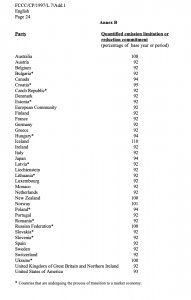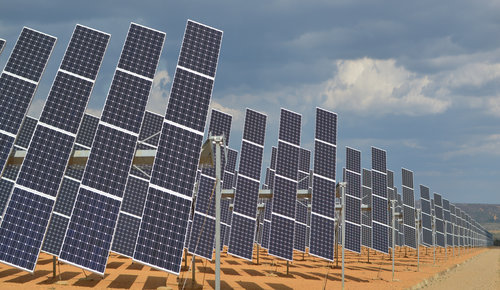The Kyoto Protocol was adopted on 11 December 1997 as global leaders met in Japan to try and tackle the increasingly pressing issue of how to deal with the transboundary nature of pollution and, ultimately, climate change. Eight years later, due to a complex ratification process, it entered into vigor on 16 February 2005.
Today the Kyoto Protocol is often regarded as both a shedwater moment in climate diplomacy and, ultimately, a failure in not least of which due to its inability to stop global GHG emissions from continuing to grow exponentially.
However, to properly analyze the Protocol’s successes and failures it is important to understand exactly what it was, what it set out to do and how it sought to achieve its goals, particularly as many of today’s climate negotiations stand on the shoulders of that shed water meeting in Japan, in the winter of 1997.
What was the Kyoto Protocol?
Initially the Kyoto Protocol brought together 180 countries to operationalize the United Nations Framework Convention on Climate Change (UNFCCC) to taking an important first step towards reducing global emissions and by committing industrialized countries and economies in transition to bring down greenhouse gasses (GHG) emissions based on agreed individual targets.
On 11 Dec, Kyoto Protocol turns 25!
– Important milestone in international climate policy
– Significantly shaped EU climate policy – EU-ETS would otherwise not exist
– Its implementation enables staying at lower T compared to delay (found again dissertation article of 2005…) pic.twitter.com/upMVjMkKRk— Prof. Niklas Höhne (@niklashoehne) November 28, 2022
The Protocol sought to set out achievable and realistic goals for emissions reductions for developed nations to decrease pollution and therefore begin to mitigate climate change. The combined effort of these reductions would need to bring emissions down by an average of 5.2% compared to 1990 levels in the first commitment period, between 2008 and 2012, which at the time would have amounted to approximately 29% of the world’s total greenhouse gas emissions.
Members of the European Union (EU) pledged to reduce their emissions by 8%, whereas the U.S. and Canada agreed to 7% and 6%, respectively, although the US, which initially ratified the agreement then dropped out in 2001 claiming that it would hurt the US economy.
Part of the US’s grievance against the Protocol was that it only concerned 37 high income countries, whereas developing countries would be given a sort of temporary free pass so that they could continue to develop. This was due to one of the most innovative – and controversial – aspects of the Protocol: common but differentiated responsibility and respective capacities.

This idea was introduced through the Protocol’s Annex B, which set binding emission reduction targets for 37 industrialized countries and economies in transition and the European Union. This was done in recognition of the fact that Annex B countries were the ones most responsible for the rise in GHG levels in the atmosphere and that they were the ones best equipped to reduce their emissions without harming their economies.
The nuts and bolts
The Kyoto Protocol set out to make emissions reductions work on the economic side by establishing flexible market mechanisms, which were structured around trade of emissions permits and continue to inform how we deal with carbon markets up to this very day.
Under the Protocol, individual countries were required to meet their pledges primarily through national measures yet they could also leverage three additional market-based mechanisms:
Emissions trading, as set out in Article 17 of the Kyoto Protocol, gave countries the chance to make use of their extra emission credits – meaning emissions that they are permitted to generate but which they have not “used” – which they can then sell to other countries countries that have already burnt through their credit targets.
The Clean Development Mechanism (CDM), defined in Article 12 of the Protocol, helped Annex B countries implement emission-reduction projects in developing countries by allowing them to earn saleable certified emission reduction (CER) credits, each equivalent to one tonne of CO2, which could be counted towards meeting Kyoto targets.
At the time the CDM was seen as a revolutionary new concept and the first global, environmental investment and credit scheme of its kind, providing a standardized emissions offset instrument, CERs.
Finally, the “joint implementation” mechanism, defined in Article 6 of the Kyoto Protocol, allowed Annex B countries to earn emission reduction units (ERUs) from an emission-reduction or emission removal project in another Annex B country.
Together these tools were designed to encourage countries to implement GHG emission reductions in those areas where they were most convenient economically and therefore cost-effective, which would also include the developing world. The idea was that the important thing was to reduce emissions and not where these reductions took place.
The Protocol also established an Adaptation Fund to finance concrete adaptation projects and programmes in developing countries that are Parties to the Kyoto Protocol. The Fund is financed with the share of proceeds from clean development mechanism (CDM) project activities and other sources.
What came after Kyoto?
The Kyoto Protocol ran its first commitment period between 2008 and 2012 and was then extended in Doha, Qatar, on 8 December 2012, with the Doha Amendment which set a more ambitious goal of reducing greenhouse gas (GHG) emissions by 18% compared to 1990 levels for participating countries.
The Doha Amendment established a second commitment period from 2013 to 2020 and only entered into force in December 2020 after the threshold number of countries deposited their instrument of acceptance and only shortly before it expired.
Although Japan, Russia, and Canada refused to take part in the second commitment period data analyzed by UN Climate Change shows the 37 developed countries that did agree to it had reduced emissions 25.3% by 2018.
Although it did have some significance in carbon accounting the Doha Amendment’s entry into force was largely symbolic and brought the Kyoto Protocol era to a close, opening the way for the Paris Agreement era.
An incredible milestone! With 144 parties now signed, the Doha amendment enters into force. This is fantastic news for our process @UNFCCC towards #ClimateAction. Many thanks Nigeria 🇳🇬 @MBuhari for your ratification!
— Patricia Espinosa C. (@PEspinosaC) October 2, 2020
In this context, the adoption of the Paris Agreement did not replace the Doha Amendment but rather helped lay the groundwork for the Paris Agreement Targets for 2025 or 2030. That said some countries, such as Australia, have suggested that they may try to use credits from overachieving its Kyoto target to meet its 2030 climate target under the Paris Agreement. This would hinder emissions reductions considerably and the bulk of the credits which they propose to come from the second commitment period covered by the Doha Amendment.






